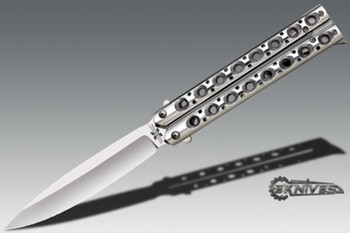Everything You Need to Know About Butterfly Knives
Posted by Clayton on Jul 21st 2015
Butterfly knives (also called balisong knives or Batangas knives) are some of the most highly coveted in the industry, as demonstrated by their great popularity among knife enthusiasts, vendors, and performers. How exactly are they structured, and why are they so popular? Let us take a brief glimpse into the world of these stylish knives.
What Is a Butterfly Knife?
The butterfly knife is a folding pocketknife crafted with two handles that rotate around a tang when opened. When closed, the blade is hidden between two grooves inside of the handles.
There are multiple parts unique to the construction of the butterfly knife, all of which play a critical role in the creation of a knife built for both power and showmanship. The following is a succinct breakdown of each accessory and tool of the blade.
The Basics
- The “key” that holds the entire knife together, the tang is the base of the knife blade. The tang attaches the handles here with pivot spins.
- Tang Pin(s). These are pins designed to keep the blade physically removed from the handle in order to stop them from dulling when the knife is closed. In many cases, butterfly knives may retain a second pin to prevent the two handles from hitting against each other while the knife is in use.
- The butterfly knife’s blade is made with a carefully designed slab of steel that occupies the knife’s center. It is held in place by two handles when the knife is closed. Though often utilized in skilled performances, one side of the blade is extremely sharp, carrying a high likelihood of injuring an inexperienced user. The other side is often blunt, with little to no chance of harming a careful user.
- The swedge is a blunt spine on the knife blade. Many balisong users sharpen their blades on the swedge on both sides to create either a more traditional blade design, or a wavy edge pattern reminiscent of the Kris sword.
- Pivot joint. Vital to the swinging circular motion of the butterfly knife, the pivot joint consists of a pin around which the blade, handle, and tang pivot.
Handles, Latches, and Safety Features
- Safe handle. The safe handle (in most butterfly knives, the handle without the latch) is the one that closes on the non-sharpened edge of the blade.
- Bite handle. This is the handle that shuts on the sharper edge of the knife blade. If not handled with the proper care and expertise, it will almost certainly cut the user if one grips the handle too close to the blade.
- The choil is the blunter edge of the knife blade. It is positioned right above the kicker, making it much easier to sharpen it when necessary.
- Kicker (or Kick). The kicker is the part of the blade that keeps the sharper edge from receiving damage by placing it away from the inside of the handle. The kicker is occasionally built with an extra tang pin just above the pivot joint.
- Latch gate. The latch gate is a small block residing within the channel of the knife’s handles. It prevents the latch from physically affecting and wearing down the blade.
- This is the standard locking system that keeps the knife securely closed. Butterfly knives often use magnets in its place in order to keep it safely shut when not in use.
- Latch, Batangas. This is the latch attached to the bite handle.
- Latch, Manila. The safe handle attaches to this particular latch.
- Latch, Spring. This latch makes use of a spring to force itself open when its accompanying handles are properly squeezed.
A Brief History
The butterfly knife hails from the Philippines, where it was called the balisong. While the etymology of the name remains unclear, it is thought to have originated from the Tagalog baling sungay. One resulting stereotype is that inhabitants of the Batangas region never go anywhere without their balisongs.
Butterfly knives are often referred to as “click-clacks” – an onomatopoeia derivation of the sound they make when opened. Butterfly knives may also be called “fan knives” due to the flicking hand motion utilized to open them, similar to the flicking open of a handheld fan.
Balisong USA (later Pacific Cutlery and then Benchmade) began manufacturing their own butterfly knives in the 1970s. Renowned knife maker Jody Samson (perhaps best known for crafting swords for the film Conan the Barbarian) designed many early iterations of the knife. In the early 1980s, the United States imported hundreds of thousands of balisong knives from China, Japan, Korea, and, of course, the Philippines.
Due to their potential of being utilized as weapons, many American states restrict their selling and usage. Butterfly knives have been outlawed or severely restricted in many countries, including Canada, Switzerland, and Australia. However, many of these same nations and states allow practice knives or issue special permits for sport, collection, or performance uses.

